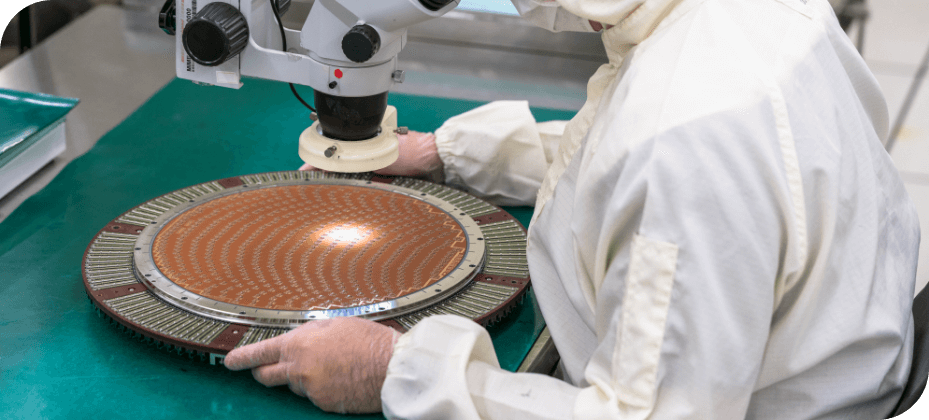Proactive Innovation, Pioneering a Zero Carbon Future
Green Design: Innovation in Sustainable Product Design
Winbond understands that following the same path won't lead to new destinations. Starting from the concept of product life cycle, Winbond focuses on selecting low-carbon raw materials, continuously improving processes and design innovation, enhancing productivity and reducing design time to achieve smaller chip sizes, fewer pins. With incorporating Design for Test (DFT) techniques, this results in smaller form factor, lower pin counts, shorter testing time, and finally significantly reducing carbon emissions generated during the manufacturing process. In addition, Winbond emphasizes the use of environmentally friendly materials for packaging, supports low-temperature soldering processes, and reduces PCB usage through smaller form factors. These efforts help downstream customers reduce overall raw material usage and energy consumption during PCBA production, further lowering carbon emissions. Moreover, Winbond commits to reduce power consumption and prolonging power usage time during the product usage phase. Besides continuously design the Flash memory with lower operating currents along with process evolution, Winbond has developed new processes and circuit architectures, and introduced the world's first NOR Flash that supports operating voltage of 1.2V. At every stage of the product life cycle, Winbond considers energy-saving and carbon reduction measures, striving towards net-zero emissions.
Winbond integrates product performance with environmental protection, ensuring a sustainable approach throughout the product life cycle

Green product innovation
In the era of portable electronic products and the Internet of Things, Winbond continues to focus on designing low-power-consumption products. For example, our value is demonstrated in the context of net-zero and environmental sustainability by offering the Known Good Die (KGD) sales model, where memory chips are packaged together with logic chips, creating energy-efficient and carbon-saving end products that prioritize low carbon emissions and green features.

With the assistance of Winbond's expertise, many customers utilize the Known Good Die (KGD) of our flash memory products for System-in-Package (SiP) solutions. Flash memory chips are stacked with controller chips and placed in a single package or module to provide SiP solutions. KGD of other components can also be stacked with flash memory KGD, saving packaging materials, improving performance, and reducing power consumption and chip size.
Winbond Group selected as one of the Top 100 Global Innovators from Clarivate
With "Aggressive Innovation" as one of our core values, Winbond was selected as one of Clarivate's Top 100 Global Innovators. The evaluation criteria for this award include not only the total number of patents, reaching 500, but also factors such as the industry influence, track record of success, globalization, and technology applications. Out of 3,200 candidate organizations worldwide, Winbond Group has been recognized, demonstrating our strength in innovative research and development, as well as the global impact of our patent portfolio. This recognition from an international evaluation institution proves that Winbond is a semiconductor company that values research and development investments, pursues growth driven by innovation, and is committed to environmental sustainability. From the product design stage, Winbond focuses on using low-carbon materials and developing green products that are high-performance, low-power, and require minimal resources. Our goal is to protect and minimize our impact on the environment.

Green Information Construction
Carbon management serves as an important indicator for mitigating climate change. In 2022, Winbond collaborated with consulting teams from Microsoft Taiwan and SoftwareOne Taiwan to develop the "Carbon Emissions Information Platform." By leveraging Microsoft's cloud services and Power Platform, Winbond has created an automated integration system for carbon emission data, enabling real-time data visualization and management.
The semiconductor manufacturing process is complex and diverse, presenting three major challenges in integrating carbon emission data: standardization, manual processing, and visualized management. The "Carbon Emissions Information Platform" addresses these challenges and provides solutions for various pain points. For example, it allows for inventorying historical data, monitoring dynamic reports, and simulating and predicting future carbon emissions based on future capacity growth. This enables the evaluation of relevant reduction measures, facilitating the construction and management of green information and supporting the goal of transitioning to a greener paradigm.
4 Steps to launch a digital zero-carbon new future
The "Carbon Emissions Information Platform" completed Step 1 calculations of GHG inventory for Scopes 1 and 2 in 2022. Winbond plans to achieve Step 4 by the end of 2023, calculating Scope 3 and product carbon emissions. Winbond will provide customers with carbon footprint data for purchased products and incorporate activity data analysis and supplier carbon emissions information. The goal is to integrate and provide real-time information and management for green products and green manufacturing through the Carbon Emissions Information Platform.



